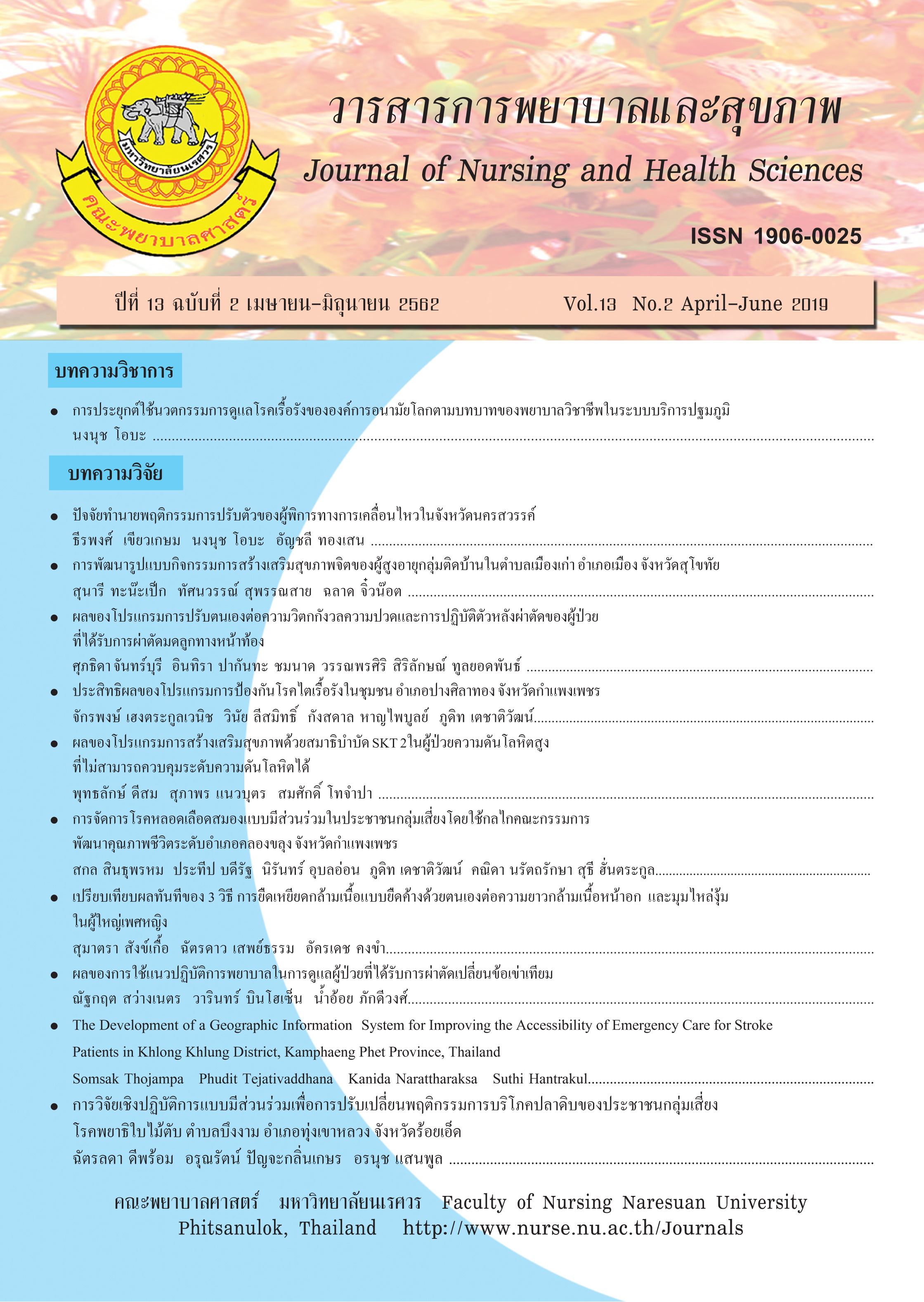Application of The WHO's Innovative Care for Chronic Conditions Framework According to The Role of Professional Nursesin Primary Health Care Level
Main Article Content
Abstract
Chronic diseases are a major problem of public health around the world, including Thailand. Prevention and controlling of chronic diseases are effective strategies in reducing risk factors. Professional nurses in primary health care level are important health personnel inmanaging to achieved goals. The WHO's Innovative Care for Chronic Conditions Framework (ICCC) is a model of care that the World Health Organization developed to suit the context of various countries and to achieve better health outcomes for patients of chronic diseases. This model consists of 3 levels of care management, including individuals and families, health service organization and community, and policy level. The implementation of WHO's Innovative Care for Chronic Conditions Framework for making better outcomes on chronic disease management by professional nurses are 1) promoting self-care for patients with family participation, 2) organizing the chronic disease service system in the hospital and community, and 3) being policy driven.
Article Details
References
Australian Institute of Health and Welfare.(2017).
Impact of overweight and obesity as a risk factor
for chronic conditions:Australian burden of
disease study.Canberra: Australian Institute of
Health and Welfare.
Barr, V.J., Robinson, S., Marin-Link, B., Underhill, L.
&Dotts, A.(2003).TheExpanded Chronic Care
Model: An integration of concepts and strategies
from population health promotion and Chronic
Care Model. Healthcare Quarterly,7(1)73-82.
doi:10.12927/hcq.2003.16763
Department of Non-Communicable Disease.(2017).
Annual report 2017.Bangkok: AusornGraphic
Publishing House.[in Thai].
Goffman, E. (1963). Stigma: note on the managementof
spoiled identity. New Jersey: Prentice-Hall.
Jaspers, L., Colpani, V., Chaker, L. Van der Lee, S.J.,
Muka, T., Imo, D., ……Franco, O.H. (2015).
The global impact of non-communicable diseases
on householdsand impoverishment: A systematic
review.European Journal of Epidemiology,30,
-188. DOI 10.1007/s10654-014-9983-3.
Kongprasert. J. (Ed.) (2015).Guideline for NCD quality
clinic (diabetes and hypertension) in sub-district
health promotion hospital. Nonthaburi: Department
of Disease Control, Ministry of Public Health.
[in Thai].
Kunee, N. & Udomchairatana, R. (Ed.). (2014). Literature
review, current situation, and service
model for non-communicable disease. Bangkok:
Art Qualified Company Limited.[in Thai].
Likitlucha, N., Attachaiwat, A., Lappugdee, T.
(Ed.).(2016). Nursing standard in community.
PathumThani: SautawanPublishing Co., Ltd.
[in Thai].
Pan American Health Organization. (2013). Innovative
Care for Chronic Conditions: Organizing
anddeliveringhigh quality care for chronic
noncommunicablediseases in the Americas.
Washington: Pan American Health Organization.
Phanfran, S. (2017).Health care system for patients
with hypertension Chiang Klang District, Nan
Province. [PowerPointslide].Retrieved from http://
www.searo.who.int/thailand/news/screeningdiagnosis-
treatment-communitydistrict.pdf. [in Thai].
Promthet, S., Saranrittichai, K., Kamsa-ard, S., Senarak,
W., Vatanasapt, P., Wiangnon, S., ..Moore, M.A.
(2015). Situation Analysis of Risk Factors
Related to Non-communicable Diseases in
KhonKaen Province, Thailand. Asian Pacific
Journalof Cancer Prevention,12, 1337-1340.
Sareelae, N., Jooprempree, K. & Munluan, K. (2018).
The stigma of patients with alcohol use disorder
with discrimination and the human rights in the
community way of life. Srinagarind Medical
Journal, 33(6),589-94.[in Thai].
Srisuphan, V & Chan Thai, K. (Ed.).(2013). Manual of
professional nurse practices in sub-district health
promotion hospital. Judtong Publishing Co., Ltd.
[in Thai].
Srivanichakorn, S. (2017).NCDs and SDG : The way
forward Thailand. Present for side event
PMAC,Centara Convention,BKK,Thailand 30
January 2017 [in Thai].
Tritipsombut,J. (2018). A follow-up study of the effects
of health education program by using an
applicationof protection motivation and social
support theories on the blood pressure control
of the hypertension Risk Groups. Srinagarind
Medical Journal,33(6) 543-550.[in Thai].
Wagner, E.H., Austin, B.T., Davis, C.., Hindmarsh, M.,
Schaefer, J. &Bonomi, A.(2001). Improving
chronic illness care: Translating evidenceinto
action. Health affairs,20(6), 64-78.
World Health Organization.(2002).Innovative Care
for Chronic Conditions: Building blocks for
action.Geneva: World Health Organization.
Retrieved Dec, 2 2018 from https://www.who.int/
chp/knowledge/publications/icccglobalreport.pdf
World Health Organization.(2018).Noncommunicable
diseases country profiles 2018.Geneva: World
Health Organization.Retrieved Dec, 2 2018 from
https://www.who.int/nmh/publications/ncdprofiles-
/en/


